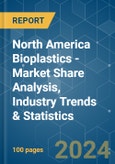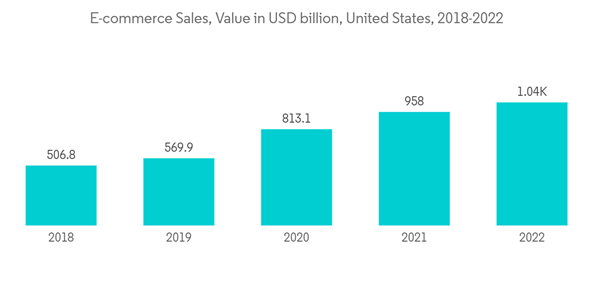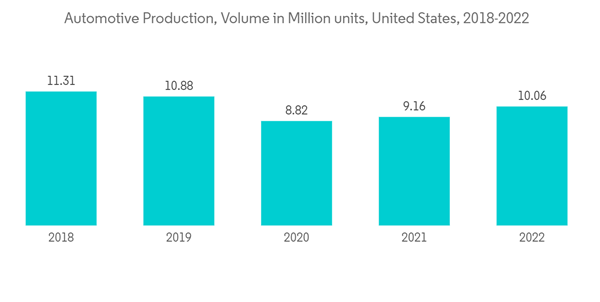Key Highlights
- The COVID-19 pandemic affected several industries negatively. The lockdown in North American countries caused disruptions in production, as well as industrial activities, and restrictions on freight transportation, disturbed the supply chain. However, the conditions started recovering in 2021, restoring the market's growth trajectory.
- The rising demand from the flexible packaging segment and the increasing rate of adoption of bioplastics are major factors driving the growth of the market studied.
- However, the availability of cheaper alternatives to traditional plastics is likely to restrain the growth of the studied market.
- Nevertheless, future prospects in construction applications are likely to create lucrative growth opportunities for the market.
- The United States represents the largest market over the forecast period due to the increasing consumption of bioplastics for packaging across e-commerce and electronics sectors.
North America Bioplastics Market Trends
Flexible Packaging Industry to Dominate the Market
- Bioplastics are used in flexible packaging, as they are not harmful to nature, and few are easily degradable as well.
- They are used in packaging films for food items, medicines, beverage bottles, packaging films, and packaging of non-food products, such as napkins and tissues, toilet paper, nappies, sanitary towels, cardboard, and coat paper for food wrapping paper, and coated cardboard to make cups and plates. Moreover, they are used in flexible and loose-fill packaging.
- The consumption of bioplastics is increasing in making plastic bags, as they are nature-friendly, and for organic waste collection bags, which are majorly used in hospitals, hotels and restaurants, commercial and retail outlets, and houses. Local governments of different countries in the region have also initiated their usage.
- Moreover, the food packaging and e-commerce industries have grown tremendously post the onset of COVID-19. The food and beverage industry in Mexico is likely to upscale with growing investments by multinational food and beverage producers. The food processing industry has recently attracted investment worth USD 700 million from Nestle to modernize its 16 factories in the country and construct a new one in Veracruz.
- The revenue from the e-commerce industry in the United States was USD 1.03 billion in 2022, indicating an increase of more than 8% over the previous year. This was also the first time that the e-commerce industry breached the USD 1 billion mark.
- With the e-commerce sector growing at a rapid pace and people adopting and preferring online shopping, starting from FMCG products and food to medicines, electronics, and others, the demand for flexible packaging in e-commerce is expected to offer several growth opportunities in the coming years.
- Therefore, such factors indicate significant scope for the bioplastics market, which is also likely to have a positive influence on demand due to increasing environmental regulations supporting the use of eco-friendly materials.
United States to Dominate the Regional Demand
- According to the Flexible Packaging Association of the United States, flexible packaging is the second-largest packaging segment in the country, with almost 20% share in the market. The largest market for flexible packaging in the United States was the food sector, accounting for more than 50% of shipments.
- The food and beverage industry is essential to the United States economy. E-commerce and delivery are also growing in popularity in the food industry. Due to the changing consumer habits, the beverage industry in the United States has noticed substantial growth. According to PMMI Beverage Report, the North American beverage industry is expected to grow by 4.5% during 2018-2028. The major portion of North American beverage sales is achieved by United States sellers.
- The revenue from the food and beverages industry in the United States was over USD 21,320 million in 2021. The revenue is expected to show an annual growth rate of over 4.7%, resulting in a projected market volume of USD 25,659 million by 2025. This is expected to increase the demand for bioplastics in flexible packaging, thereby boosting the market of study in the country over the forecast period.
- The growing e-commerce industry is also a major contributor to the bioplastic demand in the country. According to the Census Bureau of the Department of Commerce, the estimated U.S. retail e-commerce sales for the first quarter of 2023 was USD 272.6 billion, indicating an increase of 3% from the fourth quarter of 2022. Total retail sales for the first quarter of 2023 were estimated at USD 1,799.5 billion, i.e., an increase of 0.9% from the fourth quarter of 2022.
- The first quarter of 2023 e-commerce indicates growth of 7.8% from the first quarter of 2022, while total retail sales grew 3.4% during the same period. E-commerce sales in the first quarter of 2023 accounted for 15.1% of total sales.
- Moreover, factors such as technological developments, an increase in greenhouse gas emissions, increased efforts towards environmental sustainability, and vehicle end-life management have all contributed to the growing usage of bioplastics in automobiles.
- The United States is the second largest automotive manufacturing country in the globe, falling only behind China. According to OICA, the automotive production in 2022 was recorded to be 10.06 million units, i.e., an increase of 10% in comparison to the production in 2021, which was reported to be 9.1 million units.
- The National Automobile Dealers Association (NADA) predicts that US new vehicle sales are likely to increase by 6.6% to 14.6 million units in 2023. The production of automobiles is anticipated to ascend in the upcoming future owing to the rising popularity and affordability of the vehicles.
- All these end-user industry developments are going to positively impact the growth of the bioplastics market in the United States.
North America Bioplastics Industry Overview
The North America Bioplastics Market is fragmented in nature. The major players in the market (not in any particular order) include Braskem, Novamont SpA, Natureworks LLC, Indorama Ventures Public Company Limited, and BASF SE, among others.Additional Benefits:
- The market estimate (ME) sheet in Excel format
- 3 months of analyst support
This product will be delivered within 2 business days.
Table of Contents
Methodology

LOADING...










